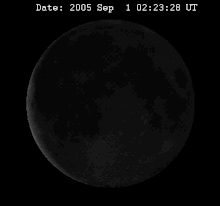Moon front

The part of the moon's surface that is visible from the earth is called the front of the moon or the side of the moon facing the earth .
As a result of two effects of the libration (inclination and elliptical shape of the lunar orbit ) the hemisphere visible at a certain point in time is not exactly the same, so that gradually about 59% of the moon's surface becomes visible from earth. The from Earth usually not visible half is far side of the moon called.
The structures on the edge of the front of the moon cannot be observed at any time, but only with certain combinations of moon phase and orbit position. They also appear strongly distorted and are therefore difficult to see. Also, structures that were leveled or eroded by further impacts can hardly be made out, so that some quite large craters only became clearly recognizable on images provided by space probes such as the Lunar Orbiters .
See also
literature
- Ernest H. Cherrington: Exploring the Moon Through Binoculars and Small Telescopes. Dover, New York 1969, 2nd edition 1984, ISBN 0-486-24491-1 , pp. 32ff
- Josef Sadil : Focus on the moon , main chapter: " Selenography " , illustrated by Gerhard Pippig, Urania, Leipzig / Jena / Berlin 1962 (original title: Cíl měsíc , translated by Max A. Schönwälder), DNB 454251394 , OCLC 65043150 .
